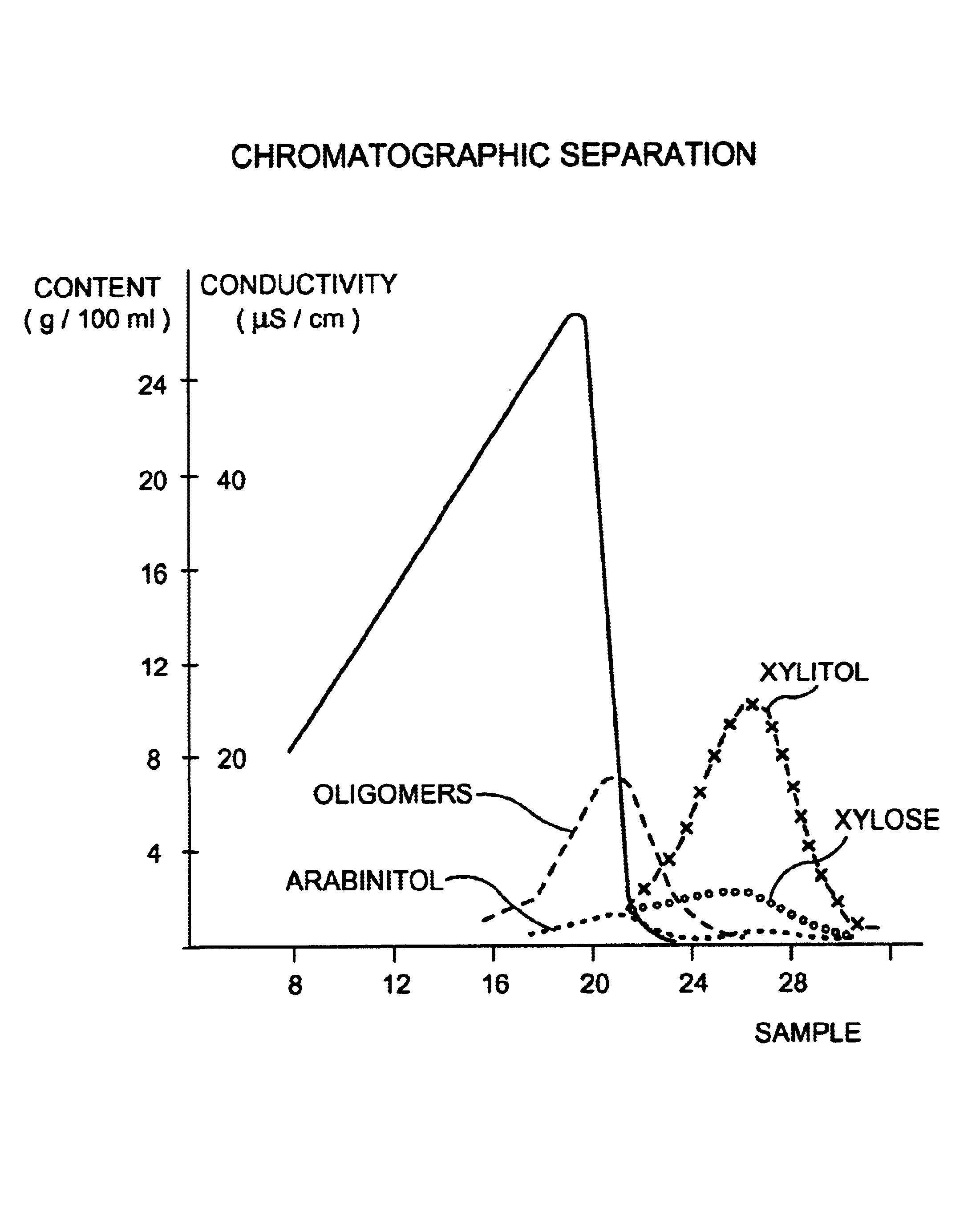Process for the simultaneous production of xylitol and ethanol
a technology which is applied in the field of process for the simultaneous production of xylitol and ethanol, can solve the problems of insufficient efficiency, relatively high price of xylitol, and limited use of xylitol, and achieves simple and effective process, high yield, and effective utilization
- Summary
- Abstract
- Description
- Claims
- Application Information
AI Technical Summary
Benefits of technology
Problems solved by technology
Method used
Image
Examples
example 1
Production of Ethanol and Xylitol from Birch Chips
A steam explosion treatment was carried out on birch chips at 215° C. with a delay time of 4.5 minutes. The apparatus used is commercially available (Stake Technology, Canada).
30 kg of chips pretreated by steam explosion were suspended in 400 l of water at 50° C. in a reactor furnished with stirring means. The pH of the suspension was regulated to 4.8 with a NaOH solution. The following enzymes were added into the reactor:
Cellulase Multifect L 2504FPU / g d.s.(Cultor)Beta-Glucosidase Novozyme 1885IU / g d.s.(Novo)Hemicellulase Multifect K(Cultor) containingxylanase18U / g d.s.β-xylosidase9nkat / g d.s.esterase2nkat / g d.s.
The reaction was started, and after three and six hours pretreated birch chips were added to the mixture to increase the solids content to 14% by weight. The hydrolysis was continued for three days at 50° C. and at a pH of 4.8. The yield after the hydrolysis was 16% of glucose and 12% of xylose on the dry weight of the pretr...
example 2
Production of Ethanol and Xylitol from Sulphite spent Liquor
The starting material used was a sugar fraction chromatographically separated from a sulphite, spent liquor (Finnish Patent Application 862273, U.S. Pat. No. 4,631,129), containing a considerable amount of hexoses, mainly glucose. The composition of the solution prior and subsequent to fermentation is shown in Table 2.
TABLE 2beforeafterIngredientfermentationfermentationdry solids,19.0—% by weightoligosacch., g / l14.810.3of dry solidsglucose g / l90.01.4xylose g / l42.03.5arabinose g / l5.02.3xylitol g / l—25.4ethanol g / l—42.0arabinitol g / l—2.8
The fermenting was carried out with a Debaryomyces hansenii strain, and 3 g / l of yeast extract, 3 g / l of malt extract and 5 g / l of peptone were added. The pH of the solution to be fermented was initially about 6.0, the temperature was about 30° C. and the fermentation was carried out in an Orbital Shaker (200 rpm).
The ethanol produced in the fermentation was recovered by distillation (50° C., 2...
example 3
Crystallization of Xylitol
Xylitol was crystallized from a chromatographically enriched xylitol solution containing 82.5% of xylitol on dry solids by evaporating the solution to 92% by weight of dry solids at 65° C. Into a solution of a natural weight of 2 200 g, xylitol crystals of about 0.04 mm were inoculated in an amount of 0.03% by weight, and the solution was cooled in 55 hours to 45° C. in accordance with the following empirical equation:
T=T1−(t / t1)**2* (T1−T2),
whereinT=temperature of solution, ° C.T1=seeding temperature (65° C.)T2=final temperature (45° C.)t=time from seeding, ht1=crystallization time (55 h)
The crystallization was carried out in a 2 l pilot crystallizer furnished with a vertical stirrer. 65% of the xylitol present in the solution crystallized as raw crystals which were separated from the mother solution in a basket centrifuge (Hettich, Roto Silenta II).
During the centrifugation, the crystals were washed with water (4% of water on the weight of the crystals). ...
PUM
| Property | Measurement | Unit |
|---|---|---|
| temperature | aaaaa | aaaaa |
| concentration | aaaaa | aaaaa |
| concentration | aaaaa | aaaaa |
Abstract
Description
Claims
Application Information
 Login to View More
Login to View More - R&D
- Intellectual Property
- Life Sciences
- Materials
- Tech Scout
- Unparalleled Data Quality
- Higher Quality Content
- 60% Fewer Hallucinations
Browse by: Latest US Patents, China's latest patents, Technical Efficacy Thesaurus, Application Domain, Technology Topic, Popular Technical Reports.
© 2025 PatSnap. All rights reserved.Legal|Privacy policy|Modern Slavery Act Transparency Statement|Sitemap|About US| Contact US: help@patsnap.com


